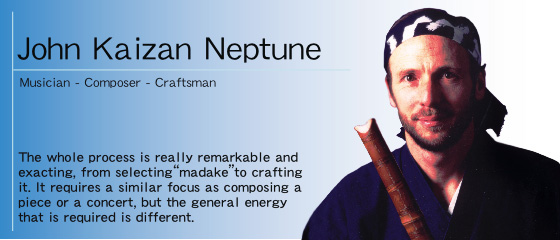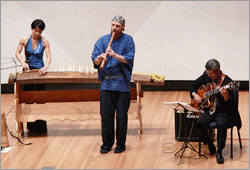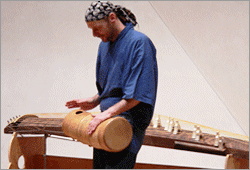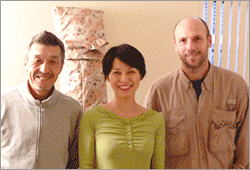YuYu interview John Kaizan Neptune
 |
| —— On stage I noticed you used several shakuhachi of varying lengths. Can you tell us a little about them and the instrument in general? Shakuhaci has many different aspects. According to some legends, the shakuhachi was brought from China to Japan more than a thousand years ago by a Zen priest and there are some people who don’t want to be thought of as musicians, they merely play a tool for mediation. In Japan Shakuhaci was traditionally, up until Meiji, “ishaku hassun” or one shaku and eight sun (1.8 Japanese feet) and so the name shakuhachi. Now the term also refers to the range of lengths from 1.3 shaku to 2.5 shaku or longer. The three sizes which I played are quite common now and mostly came about after WWII, so it’s quite a modern development. Some suit certain styles better than others, for example to accompany vocals a longer flute sounds better. For my encore I end on a mini-shakuhachi, only 4.5cm long, which is shrill but kind of a cute thing for an encore. —— Have you always had an interest in music? 
On stage during a recent La Jolla appearance, John (center), Masayo (left) and Takao (right) share a wonderfully different kind of shakuhachi experience with their audience.
I grew up in a musical family; my dad played Jazz trombone; my mom was a violin player; my grandmother was a piano teacher; my brother played in a rock band and my sister sang in one and my other sister was classical pianist. We all did a lot of stuff, but I never really thought I would be a professional musician because I was a little too enamored with sports…especially surfing. I played in the school bands, trumpet, and then in early high school I sort of faded out of organized band because I wanted to go to the beach after school. There’s was only so much time, so after school do you want to march, play baseball or go surfing? Well after I got my driver’s license I was out at the beach almost everyday! I still had a great love for music and got a hold of my brother’s drum set and played in rock band for a while and I continued doing that even after I enrolled in the University of Hawaii, but really the main purpose of going to Hawaii was to surf. —— Hawaii is where you were introduced to ethnomusicology and the shakuhachi, right? Yeah, but actually, I was studying Chinese philosophy and the kinds of things I was learning said that I shouldn’t be in this competitive university environment. I felt like I was just plugging into the world situation that in essence I didn’t really want to support, so I decided I was going to drop out. So when I told my parents my dad says, “Well you know there are a lot of different paths to the top of the mountain.” Can you imagine the understanding he showed? —— And I thought you were the Chinese philosophy major! Well, you could see why I had an interest to begin with. But since I had already paid for one semester…I started asking around to see what would be an interesting class or who might be an interesting teacher. One was “Introduction to World Music” and as it turned out they were just forming a new undergraduate program “Ethnomusicology” and I was one of their first recruits. The teachers were just fantastic people and they really grabbed me. After taking a year off I realized, while didn’t think I wanted to be in school, that program was something that I couldn’t get anywhere else in the world. Not just the university, but they have an incredible multi-cultural community. So I thought, “Maybe I need to be here a little while longer.” —— So I guess that’s how you discovered the shakuhachi? 
Marching to the beat of a different drummer. John introduces the unique sound of the“uduboo”he handcrafted from giant“moso”bamboo.
Shakuhachi was my special research project. I was shopping the whole world of music for an interesting tradition and instrument to focus on because I may actually visit that country and spend a lot of time researching and writing on it. Of course nothing was going to come of it, but little did I know at that time it would totally change my life. I was playing drums, so I was very interested in percussion, but there didn’t happen to be any tabla teachers in Hawaii, so because of that I went for my second choice, the shakuhachi. And so I started. There was a teacher, a priest who lived right down the street from the university who I studied with. He was very kind; his English was good enough to communicate with me and he was very patient—and he seemed to be okay with a blond surfer who had fairly serious interest in this traditional bamboo flute. —— What was it about the shakuhachi that really interested you? Why was shakuhachi way up there among my top choices? Well at school I was working in the listening library and whenever I could I’d listen to an LP on a spare turntable. I must’ve listened to over 3000 recordings—that’s a lot of listening—and I heard a lot of really great music and the one instrument that really stood out was the shakuhachi, particularly its tone color. Here is this flute player that is purposely making this wild breathy sound. That really got me…then when I found out that it was a simple end-blown bamboo flute with only five holes, I knew something neat was really going on here. The simplicity of its design, the material, bamboo being the epitome of eastern culture, and the fact that it was a solo tradition, all appealed to me. Here is this bamboo flute that I can put in my backpack, go anywhere, and play by myself. I mean what more could you ask? And it’s an excellent backscratcher! —— So your path eventually led you to Japan to study? It was independent research with a focus, because if you want to learn about something you go to the source. I was this ethnomusicologist and through the shakuhachi I was going to study Japanese culture. So why not go to Japan for a year? Of course, nothing is ever going to come of it because what can I do with it commercially, right? But maybe I could eventually write a paper about it or get a master’s degree or something; that was my initial feeling. So I went to Kyoto and studied in the Tozan school and after a year I passed the sub-master exam, but there is mandatory 3-year waiting period before you are even allowed to take the master-exam. So during that time I went back and finished my degree before resuming my studies in Kyoto, and about six-months later I was able to take and pass the “shi-han” or masters exam. When I returned my plan was a little open ended. I thought I would be there for at least 2 years, but I wasn’t really sure how long I would be there…that was almost 27 years ago. —— How is it that you came to have a Japanese name? 
John in his natural element-among the giant bamboo!
My real name is John David Neptune, but in the Tozan school to which I belong, if and when you pass the “shi-han”, which is a two-day exam, comes an honorary name which infers that you are a Tozan school member. The tests are all conducted by a panel that sits behind screens, so judges have no idea who is playing, just how and what is being played. You play it and go on to the next room. They’re pretty strict and I think less than 50% of the people who attempt it succeed, so receiving your name is quite an honor. You are given the “yama” which is the “zan” part, but you and your sensei can generally choose the first-half of your name. In my case Neptune means “king of the seas” and so “kai” became an obvious choice. Kaizan means Ocean–mountain, so what a great name for me. It’s got the highs and lows, earth and water …the whole spectrum, so I feel pretty lucky! —— Can you touch on what exactly the Tozan school is? Even though they refer to Tozan as a school it is more like a style of playing, so it isn’t in a particular location; it is more of a group. The style was developed at the turn of the century by a very famous and dynamic player who passed away in the 1950’s. He was a contemporary musician and he did a few things to make it more popular; he used a lot of elements from the old style and composed his own solo repertoire. He also arranged his pieces for koto and shakuhachi in a little more musical manner and he wrote more pieces for multiple shakuhachi so people could get together and play. Up until that time it was almost all solo music. —— So he expanded the boundaries… Exactly. —— Like you’ve continued to do? In a sense. I would never compare myself to him, but musically I’ve tried to explore new ground with the shakuhachi. —— What led you to start making your own shakuhachi? I think every shakuhachi player would be interested in making their own instrument if they could, and I had that feeling like everyone else. What really pushed me to devote all the time, energy and work was that in the end, I couldn’t buy a flute that would give me the kind of response that I wanted —no matter how much I spent on one. I was getting my flutes from top-notch makers, but I still wasn’t satisfied. Perhaps because I place such high demands on my instruments, more than most people do, I was hearing or exposing things that other professionals didn’t—but I knew. So I thought if I’m going to complain about it then maybe I should get in there and do it myself. Maybe I was the one who could make a flute that I was going to be really happy with. So I started and it worked. That was a real turning point for me. So now there’s quite a demand for my shakuhachi and I feel fortunate that I’ve got this whole other thing that isn’t on the road or some intense recording kind of experience. I can be at home working on flutes late at night or early in the morning, whenever I want to work. It’s right there in my house sitting there and then working with the natural material of bamboo is so great. —— What’s involved in making a shakuhachi? It’s not like you grab just any piece of bamboo. It’s great. The whole process is really remarkable and exacting, from selecting “madake” to crafting it. It requires a similar focus as composing a piece or a concert, but the general energy that is required is different. It’s not easy to explain, and there are different aspects; obtaining the material and participating in nature and then the crafting of the instrument. I harvest the bamboo from the grooves next to where I live. I take some coffee and a sandwich and when it’ time to take a break I find my favorite tree stump in the groove. It’s those times I know there isn’t anywhere I’d rather be in the world. And this is my space—way to go! After the bamboo is cut, the oils are removed and it will be aged for six months to two years. In actually making a shakuhachi the most critical aspect is shaping the bore of the instrument to get the right sound. That’s the most difficult thing and the shape determines the tone quality, pitch, and balance. If one part is a little bigger another part will be a little bit smaller, so the relationship among all the acoustics is incredibly complex. —— Is it more of a science or an art? It’s both! It is built on an incredible amount of science, but if the art is not in there it won’t work. There are so many parameters that you don’t have control over so the art of crafting this is critical. With many string instruments, a string vibrates, that resonates into the wood and the wood, string and the bridge vibrate, so if you put your hand on the wood it dampens the sound. But for the shakuhachi it isn’t the material that is vibrating—it is the air column! I know that’s sacrilegious to most shakuhachi players, but true. If you were to grab the shakuhachi while I’m playing, unless you are covering up a whole, it won’t do anything to the sound, so shaping the bore is critical. —— As I was listening to your wonderful performance I had the thought that unlike a movie where a director is manipulating what you see, think and feel; good music touches people’s souls and sets them free. 
Taking a moment out of their busy schedule (R-L) Takao Naoi, Masayo Norikura and John Kaizan Neptune.
Exactly true. That’s very perceptive. There is a direct vibration that actually physically touches you through the air and that is powerful. One thing, I never feel like its me; I feel like it’s the music and the bamboo and I feel like I am participating in it too! Especially with that kind of energy and the kind of high that you get when you have that many people sharing the space. It’s kind of a natural process and I‘m just up there having a good time sharing this vibration, not only with the people on the stage but the people in the audience. My favorite phrase in the Japanese language is “okage sama de” Thanks to you, thanks to the wonderful people that made this hall, thanks to San Diego, thanks to CA and thanks to the world. Thanks to the universe this is all possible…well thank you everybody. You’ve got to have a little bit of that understanding that we are all in this together. One incredibly moving experience, at a show I did for some seriously ill patients really illustrates this. It was in a beautiful hall and the program had a western harp player, who performed some wonderful Bach and Mozart pieces and halfway through I had a solo. Well, after a minute a woman started to sing, and I don’t mean just humming along, I mean she was as loud as I was and it sounded as if somebody was strangling her. I thought “Oh God, what’s going on?” Normally when kids are making noise their parents will take them outside, but nobody was taking this woman out and the acoustics were great, because she was echoing throughout the whole hall. (laughing) I didn’t know what I should do, so I just kept on playing. When I finished, we finished together, I looked in the direction where this event was taking place and I could see the nurses…they had tears in their eyes. Later they told me that for 3 years that woman had been totally non-responsive. She hadn’t responded to food, relatives, she hadn’t talked-nothing for 3 years-until she started singing along. That is the power of the vibration that music makes and its ability to touch people. What a gift. —— How did you come to develop this unique style that draws on so many influences? Well originally I had no intention of playing anything but traditional music, but for me its a process; you haven’t arrived anywhere—it’s a never ending process. You feel fortunate for that freedom and then there are the people who don’t understand why it’s not more traditional and I’m fine with that. People have often said your doing all this wild stuff “What’s the vibe from the guys doing the strictly traditional stuff?” Well you would be surprised at how totally open they are. They are so into the shakuhachi that I think it doesn’t matter which direction you take, if you do it well they are behind you. I always say, “I water the roots all the time and that is what is connecting you, but where I’m more well known is in that green stuff.” —— Any parting words of wisdom? Yareba dekiru! IF you do it, it is possible. I’m an American making a living playing shakuhachi… if you do it, it’s possible. My thing is that it is the doing that is important. I think a lot of people have dreams and that’s where they end. The dreaming isn’t the problem—it’s the realization of it. Regardless of failure and career and being accepted …if you do it, it is possible. (12-16-2005 issue, Interviewed by Terry Nicholas) |

